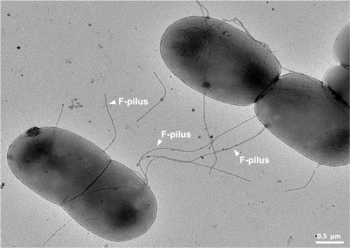Bacterial conjugation is the transfer of genetic material between bacterial cells by direct cell-to-cell contact or by a bridge-like connection between two cells.[1] This takes place through a pilus.[2][full citation needed] It is a parasexual mode of reproduction in bacteria.

It is a mechanism of horizontal gene transfer as are transformation and transduction although these two other mechanisms do not involve cell-to-cell contact.[4]
Classical E. coli bacterial conjugation is often regarded as the bacterial equivalent of sexual reproduction or mating since it involves the exchange of genetic material. However, it is not sexual reproduction, since no exchange of gamete occurs, and indeed no generation of a new organism: instead an existing organism is transformed. During classical E. coli conjugation the donor cell provides a conjugative or mobilizable genetic element that is most often a plasmid or transposon.[5] Most conjugative plasmids have systems ensuring that the recipient cell does not already contain a similar element.
The genetic information transferred is often beneficial to the recipient. Benefits may include antibiotic resistance, xenobiotic tolerance or the ability to use new metabolites.[1] Other elements can be detrimental and may be viewed as bacterial parasites.
Conjugation in Escherichia coli by spontaneous zygogenesis[6] and in Mycobacterium smegmatis by distributive conjugal transfer[7][8] differ from the better studied classical E. coli conjugation in that these cases involve substantial blending of the parental genomes.
- ^ a b Holmes, Randall K.; Jobling, Michael G. (1996). "Genetics". In Baron S (ed.). Genetics: Conjugation. in: Baron's Medical Microbiology (4th ed.). Univ of Texas Medical Branch. ISBN 0-9631172-1-1. PMID 21413277.
- ^ Dr.T.S.Ramarao M.sc, Ph.D. (1991). B.sc Botany-Volume-1.
- ^ Patkowski, Jonasz (21 April 2023). "F-pilus, the ultimate bacterial sex machine". Nature Portfolio Microbiology Community.
- ^ Griffiths, AJF (1999). An Introduction to genetic analysis (7th ed.). San Francisco: W.H. Freeman. ISBN 978-0-7167-3520-5. Archived from the original on 2020-02-08. Retrieved 2023-08-11.
- ^ Ryan, K.J.; Ray, C.G., eds. (2004). Sherris Medical Microbiology (4th ed.). New York: McGraw Hill. pp. 60–64. ISBN 978-0-8385-8529-0.
- ^ Gratia, Jean-Pierre; Thiry, Marc (1 September 2003). "Spontaneous zygogenesis in Escherichia coli, a form of true sexuality in prokaryotes". Microbiology. 149 (9): 2571–2584. doi:10.1099/mic.0.26348-0. PMID 12949181.
- ^ Gray, Todd A.; Krywy, Janet A.; Harold, Jessica; Palumbo, Michael J.; Derbyshire, Keith M. (9 July 2013). "Distributive Conjugal Transfer in Mycobacteria Generates Progeny with Meiotic-Like Genome-Wide Mosaicism, Allowing Mapping of a Mating Identity Locus". PLOS Biology. 11 (7): e1001602. doi:10.1371/journal.pbio.1001602. PMC 3706393. PMID 23874149.
- ^ Derbyshire, Keith M.; Gray, Todd A. (17 January 2014). "Distributive Conjugal Transfer: New Insights into Horizontal Gene Transfer and Genetic Exchange in Mycobacteria". Microbiology Spectrum. 2 (1). doi:10.1128/microbiolspec.MGM2-0022-2013. PMC 4259119. PMID 25505644.